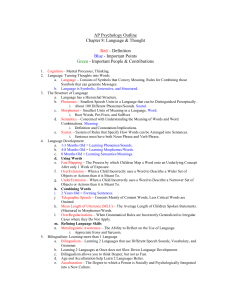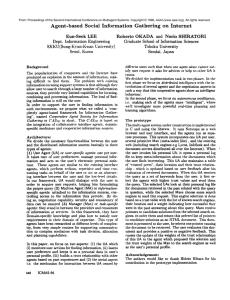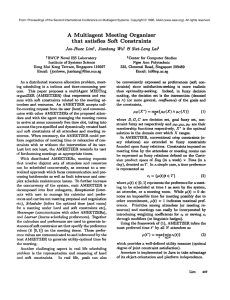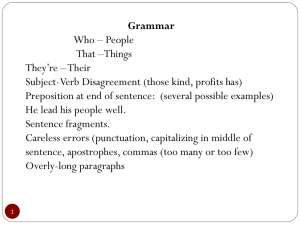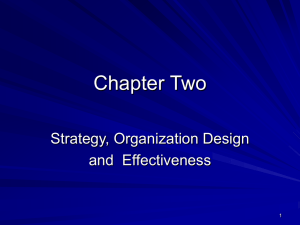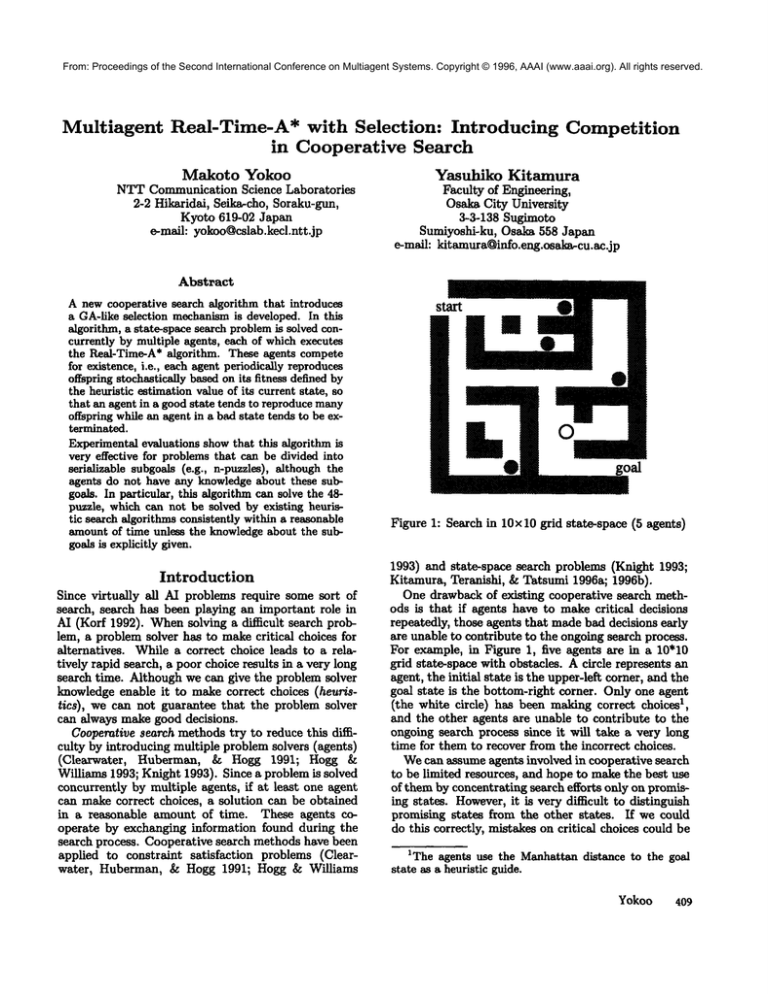
From: Proceedings of the Second International Conference on Multiagent Systems. Copyright © 1996, AAAI (www.aaai.org). All rights reserved.
Multiagent
Real-Time-A*
with Selection:
Introducing
in Cooperative
Search
Makoto Yokoo
NTT Communication
ScienceLaboratories
2-2Hikaridai,
Seika-cho,
Soraku-gun,
Kyoto619-02Japan
e-mail:
yokoo@cslab.kecl.ntt
.jp
Competition
Yasuhiko Kitamura
Faculty of Engineering,
Osalm City University
3-3-138 Sngimoto
Sumiyoshi-ku, Osaka 558 Japan
e-maih kitamura~info.eng.osaka-cu.ac.jp
Abstract
A new cooperative search algorithm that introduces
a GA-like selection mechanismis developed. In this
algorithm, a state-space search problemis solved concurrently by multiple agents, each of which executes
the Real-Time-A* algorithm. These agents compete
for existence, i.e., each agent periodically reproduces
offspring stochastically based on its fitness defined by
the heuristic estimation value of its current state, so
that an agent in a good state tends to reproduce many
offspring while an agent in a bad state tends to be exterminated.
Experimental evaluations showthat this algorithm is
very effective for problems that can be divided into
serializable subgoals (e.g., n-puzzles), although the
agents do not have any knowledgeabout these subgoals. In particular, this algorithm can solve the 48puzzle, which can not be solved by existing heuristic search algorithms consistently within a reasonable
amount of time unless the knowledgeabout the subgoals is explicitly given.
Introduction
Since virtually all AI problems require some sort of
search, search has been playing an important role in
AI (Korf 1992). Whensolving a difficult search problem, a problem solver has to make critical choices for
alternatives. While a correct choice leads to a relatively rapid search, a poor choice results in a very long
search time. Although we can give the problem solver
knowledge enable it to make correct choices (heuristics), we can not guarantee that the problem solver
can always make good decisions.
Cooperative search methods try to reduce this difficulty by introducing multiple problem solvers (agents)
(Clearwater,
Huberman, & Hogg 1991; Hogg
Williams 1993; Knight 1993). Since a problem is solved
concurrently by multiple agents, if at least one agent
can make correct choices, a solution can be obtained
in a reasonable amount of time. These agents cooperate by exchanging information found during the
search process. Cooperative search methods have been
applied to constraint satisfaction problems (Clearwater, Huberman, & Hogg 1991; Hogg & Williams
start
¯
0
Figure 1: Search in 10xl0 grid state-space (5 agents)
1993) and state-space search problems (Knight 1993;
Kitamura, Teranishi, & Tatsumi 1996a; 1996b).
One drawback of existing cooperative search methods is that if agents have to make critical decisions
repeatedly, those agents that made bad decisions early
are unable to contribute to the ongoing search process.
For example, in Figure 1, five agents are in a 10"10
grid state-space with obstacles. A circle represents an
agent, the initial state is the upper-left corner, and the
goal state is the bottom-right corner. Only one agent
1,
(the white circle) has been making correct choices
and the other agents are unable to contribute to the
ongoing search process since it will take a very long
time for them to recover from the incorrect choices.
Wecan assume agents involved in cooperative search
to be limited resources, and hope to make the best use
of them by concentrating search efforts only on promising states. However,it is very difficult to distinguish
promising states from the other states. If we could
do this correctly, mistakes on critical choices could be
1TheagentsusetheManhattan
distance
to thegoal
state
asa heuristic
guide.
Yokoo 409
From: Proceedings of the Second International Conference on Multiagent Systems. Copyright © 1996, AAAI (www.aaai.org). All rights reserved.
avoided, and multiple agents would be unnecessary. By
concentrating the agents on incorrect states, we lose
the benefit of the diversity of decisions.
In this paper, we develop a cooperative search algorithm that introduces competition among agents,
just like the selection mechanismin genetic algorithms
(GAs) (Goldberg 1989). More specifically,
each agent
solves a state-space search problem using the RealTime-A* algorithm (Knight 1993; Korf 1990). Periodically, each agent reproduces offspring stochastically
based on its fitness defined by the heuristic estimation
value of its current state. In other words, if an agent
is in a state with a good heuristic evaluation value, it
tends to have more offspring in the next generation,
while if an agent is in a state with a bad evaluation
value, it tends to be exterminated. By introducing the
selection mechanism, this algorithm can concentrate
agents on promising states without sacrificing the diversity of decisions too much.
Experimental evaluations show that this algorithm
is so effective for n-puzzles that it can solve the 48puzzle. A careful examination of the algorithm execution traces reveals that the algorithm with the selection mechanismutilizes the existence of serializable
subgoals (Korf 1988; NeweU& Simon 1972), although
the agents do not have any knowledgeabout these subgoals.
In the following of this paper, we briefly describe
the Real-Time-A* algorithm and the Multiagent RealTime-A* algorithm. Then, we show the Multiagent
Real-Time-A* algorithm with selection, and present
experimentalresults that illustrate the efficiency of this
algorithm. Finally, we give discussions clarifying the
reason for the dramatic speed-up in solving n-puzzles
and the relation with GAs.
Multiagent
Real-Time-A*
Algorithm
Real-Time-A*
The goal for a state-space search problem (Pearl 1984)
is to find a path from an initial state to a goal state. A
typical example problem is the 8-puzzle (Figure 2).
this puzzle, there exist eight numberedtiles arranged
on a 3 x 3 board. The goal is to transform the given
initial state to the goal state by sliding tiles onto an
empty square.
State-space search algorithms can be divided into
two groups: off-line and real-time. Off-line algorithms,
such as the A* algorithm (Pearl 1984), compute an entire solution path before executing the first step in the
path. Real-time algorithms, such as the Real-TimeA*(Korf 1990), perform sufficient computation to determine a plausible next move, execute that move, then
perform further computation to determine the following move, and so on, until the goal state is reached.
These algorithms can not guarantee to find the optimal solution, but usually find a suboptimal solution
more rapidly than off-line algorithms.
410
ICMAS-96
initial state
goalstate
1 2
3 4 5
6 7 8
n
m
11316
Figure 2: Exampleof a state-space search problem (8puzzle)
The Real-Time-A* algorithm can be considered as
a kind of hill climbing search. However, the algorithm
revises a table of heuristic estimates of the distances
from each state to the goal state during the search
process. Therefore, the algorithm is not trapped in a
local minimumand is guaranteed to be complete in the
sense that it will eventually reach the goal, if certain
2.
conditions are satisfied
The Real-Time A* repeats the following steps 3 until
the goal state is reached. Let x be the current state of
the problem solver.
1. Calculate f(x’) = h(x’) + k(x, for eachneighbor
x’ of the current state x, where h(x’) is the current
heuristic estimate of the distance from x’ to the goal
state, and k(x, x’) is the distance between x and x’.
2. Moveto a neighbor with the minimumf(x’)
Tics are broken randomly.
value.
3. Update the value of h(x) to the second-best f(x’)
value.
The reason for updating h(x) to the second-best
value is that if the problem,solver visits x again, the
problem solver will take the best of the alternatives
that were not chosen (the second-best).
It must be noted that there are two alternative interpretations of the Real-Time A* algorithm. One interpretation is that this algorithm is a fast search algorithm that can produce an acceptable solution very
rapidly. Another interpretation is that this algorithm
is on-line, i.e., it represents the situation in which an
agent is interleaving planning and actions in the realworld. In this paper, we employ the first interpretation, and try to further improve the efficiency of the
Pteal-Time A* algorithm. Of course, in some applications, e.g., the exploration in unknownenvironment
by multiple robots, we can employ the second interpretation for the Multiagent Real-Time A*. However,
2Theseconditions arc as follows: the problemspace is
finite, all edge costs are positive, there exists a path from
everystate to the goal state, and the valuesof initial heuristic estimatesare finite.
~This algorithm showsthe procedure for thc case the
depth of the look-aheadhorizon is 1.
From: Proceedings of the Second International Conference on Multiagent Systems. Copyright © 1996, AAAI (www.aaai.org). All rights reserved.
the technique we introduce in this paper (the selection/rearrangement of agents) can not be performed
without requiring additional costs if actions are performed in the real-world.
Multiagent
Real-Time
A*
In the Multiagent Real-Time-A* algorithm (Knight
1993), multiple agents solve a commonstate-space
search problem concurrently using the Real-Time-A*.
Each agent has enough knowledge to solve the problem alone and maintains its history, i.e., the sequence
of the states it has visited. Whenan agent reaches the
goal state, its history is a solution.
Although the agents do not need to communicate to
find a solution, we assume that agents communicate
by sharing a single table of heuristic estimates 4. Thus,
one agent can benefit from the experience of another.
Since there are a large number of random tie-breaks
in the Real-Time A*, the current states of agents are
dispersed eventually even though the agents share the
same table of heuristic estimates.
Selection in Multiagent Real-time A*
Weintroduce a GA-like selection mechanism into the
Multiagent Real-Time-A* by the following procedure.
Let us assume the heuristic estimate of agent i’s current state is represented as hi, and the number of
agents is n. Let us count a single concurrent move
of agents as one step. Once in a certain number of
steps T, each agent stochastically generates its offspring, then the agent is terminated. The total number of agents in the next generation is fixed to n. Each
offspring inherits the history of its parent, and restarts
the search process from the state where the parent was
terminated. The next generation is created by the following procedure.
for i -- 1 to Tt do
if hi = minks{i,2..... n} hk then
create one offspring of agent i;
else select one agent from {1,2,... ,n}
and create one offspring, where the selection
n1 1/hk ;
probability of j is h~ ~-~_~
end if;
end do;
The selection probability of agent j in each iteration is proportional to 1/hj 5. We can assume that
1~hi represents the fitness of agent j. Also, the agent
with the best heuristic estimate always has at least one
s.offspring
4Theshared h values are no longer admissible from the
other agents’ perspective, even if the initial h values are
admissible. However,non-admissibleheuristic estimates do
not affect the completenessof the algorithm.
5Weassumehj is non-zero except the goal state.
SThis strategy is called elitism in GAstudies (Goldberg
1989).
Table 1: Evaluation in grid state-space search (selection interval=100)
steps I solution
algorithm
length
1 agent
6795.1
403.8
10 agents, without selection
1948.7
404.4
10 agents, with selection
1572.3
400.2
For example, assume that there exist only two
agents, and the estimate of agent l’s current state is
99, and the estimate of agent 2’s current state is 1.
Then, from the above procedure, with a 99% chance,
agent 2 has two offspring, and with a 1% chance, each
agent has one offspring.
Evaluations
In this section, we showthe effect of the selection mechanism in the Multiagent Real-Time A* using experimental evaluations for typical benchmark problems,
i.e., grid state-space search problems and n-puzzles.
Grid State-Space
Search
The first problem is a grid state-space search problem
such as the one in Figure 1. There exists a grid statespace with randomly positioned obstacles. We allow
moves along the horizontal and vertical dimensions,
but not diagonal motions. The initial state is at the
upper-left corner and the goal state is at the bottomright corner. Wegenerate 120 x 120 grid state-spaces,
in which the ratio of obstacles is 40%.Aninitial value
in the table of heuristic estimates is the Manhattan
distance to the goal state.
Weshow the average of required steps for 100 trials (10 trials for each of 10 randomly generated problems) in Table 1. A concurrent single moveof agents is
counted as one step. Weshow the case that only one
agent solves the problem, the case that 10 agents solve
the problem without the selection mechanism, and the
case that 10 agents solve the problem with the selection
mechanism,in whichthe selection interval is 100, i.e., a
selection is performed once in 100 steps. Furthermore,
we show the average length of the obtained solution,
i.e., the length of the path after removingloops. As the
table shows, by introducing the selection mechanism,
we can obtain about a 20%speed-up.
To illustrate
the effect of the selection interval
and the number of agents, we show results from the
10 agents’ case, varying the selection interval (Figure 3(a)), and from the case that the selection interval
is fixed to 100, while the number of agents is changed
(Figure 3(b)).
Wecan see that if the selection interval is too short
(e.g., 1), the agents are concentrated too muchin one
direction, and introducing the selection degrades the
Yokoo
411
From: Proceedings of the Second International Conference on Multiagent Systems. Copyright © 1996, AAAI (www.aaai.org). All rights reserved.
~ with selection
withoutselection
7000-.
6ooo-i
-t
2500]
1500-
.....
-i
3000]
~
withselection
withoutselection
5000- !
...........................
~
~ ~
/
’2ooo...............................
5oo-
1000-
O- ¯ ¯ " " l ....
0 !00
I ....
I ....
i ....
i
20O 3OO 40O 5O0
selection interval
0
....
I
....
i
....
i
10
20
30
numberof agents
(a)
....
a
40
(b)
Figure 3: Evaluation in grid state-space search (effect of selection interval/number of agents)
withselection
.....
withoutselection
Table 2: Evaluation in 24-puzzle (selection interval=5)
algorithm
1 agent
5 agents, without selection
5 agents,
withselection
steps
solution
length
66901.7 23538.6
14815.9
7648.6
2942.0
1154.7
search performance. Otherwise, the selection
nism is beneficial.
mecha-
N-puzzle
Weshow the required steps for the 24-puzzle (the averages of 100 trials with different randomly generated
initial states) in Table 2. Aninitial value in the table
of heuristic estimates is the sum of Manhattan distances of wrongly placed tiles. Weshow the case that
only one agent solves the problem, the case that five
agents solve the problem without the selection mechanism, and the case that five agents solve the problem
with the selection mechanism (in which the selection
interval is 5). To illustrate the effect of the selection
interval, we show results from the five agents’ case,
varying the selection interval (Figure 4).
Furthermore, we show the required steps for the 35puzzle and 48-puzzle (the averages of 100 trials with
different randomlygenerated initial states) in Table 3.
In order to terminate the experiments in a reasonable amount of time, the total number of steps over
agents is limited to one million (each agent can take at
most 200,000 steps in 5 agents cases), and we interrupt
any trial that exceeds this limit. Weshowthe average
of successfully terminated trials only, and showthe ratio of successfully terminated trials within the limit.
412
ICMAS-96
1600014000- .......................
12000e~
lOOOO:
¯"d8ooo~
20000 ....
[,, ,, i,,, .i,.,. i,,,.
i,,,, i, ,,[,,..i,,,,i,,,,K
0 5 10 15 20 25 30 35 40 45 50
selectioninterval
Figure 4: Evaluation in 24-puzzle (effect of selection
interval)
As these results illustrate, the effect of introducing the selection mechanismis very impressive for npuzzles. As far as the authors: knowledge, there has
been no unidirectional heuristic search algorithm that
can ,solve the 35- or 48-puzzle consistently, using the
Maalhattan distance as the only guide.
To confirm this fact, we are going to showthe evaluation results of two well-knownoff-line search algorithms. One is the weighted-A* (WA*)algorithm(Korf
1993), whcre f(z) = h(z). This algorithm tends
exhaust available memoryvery rapidly since it needs
to store all expanded nodes in the open or close list.
Another one is the recursive best-first search (RBFS)
algorithm(Korf 1993), where f(x) = g(x) + W x h(x).
This algorithm can run in linear space. The parameter
Wrepresents the weight on h. If W= 1, this algorithm
finds the optimal solution. Koff reports that. required
From: Proceedings of the Second International Conference on Multiagent Systems. Copyright © 1996, AAAI (www.aaai.org). All rights reserved.
pr°blem
35-puzzle
48-puzzle
Table 3: Evaluation in 35-/48-puzzle (selection interval=5)
I alg°rithm
soluti°n
l steps
lengthI
1 agent
5 agents,
without
selection
5 agents,
withselection
1 agent
5 agents,
without
selection
5 agents,
withselection
420489.4 219553.3
83346.7
46827.4
8685.5
3198.0
393439.0 228849.0
125723.0 14527.0
35452.7 11045.0
0.42
0.43
1.0
0.02
0.01
1.0
Table4: Evaluation
in 35-/45-puzzle
(WA*and RBFS)
problem
algorithm
steps
solutiOnlength
[ ratio
35-puzzle
48-puzzle
WA*
RBFS
WA*
RBFS
time for finding a solution is optimized when Wis set
to 3 in the 15-puzzle in (Korf 1993). This is because
RBFStends to explore all possible paths to a given
node, and the number of duplicate nodes explodes as
the search depth increases. Since increasing the weight
on h increases the search depth, small weights can work
better than large weights.
Wesolved the problem instances used in Table 3
by these algorithms. The results are summarized in
Table 4. Weset the memory limit of the WA*to one
million, and the limit of expanded nodes in the RBFS
(W= 3) to 10 million. Weshow the average steps (the
number of expanding a node) of the solved instances,
and the ratio of successfully solved instances. Wecan
see neither of these algorithms can solve the 35- or
48-puzzle consistently, although these algorithms can
produce shorter solutions if they can find them.
Discussions
SerializableSubgoals
Whyis theselection
mechanism
veryeffective
fornpuzzles?
A carefulexamination
of the algorithm
execution
traces
reveals
thatthisalgorithm
utilizes
the
existence
of serializable
subgoals
(Korf1988;Newell
Simon1972).
A problem
hasserializable
subgoals
iffthegoalcan
bedivided
intoa setofsubgoals,
andthereexists
anorderingamongthesubgoals
suchthatthesubgoals
can
alwaysbe solvedsequentially
without
everviolating
a
previously
solvedsubgoal
in theorder(Korf1988).For
example,
if we solvethebottomrow of the 15-puzzle
as a subgoal,
thenwe canalwayssolvetherestof the
problemwithoutdisturbing
the bottomrow.Furthermore,if we solvetherightcolumn
as thenextsubgoal,
110397.3
1058833.0
189241.9
1968.2
0.6
297.7 0.06
3151.0
0.1
0
the problem is reduced to the 8-puzzle (Figure 5).
Let us examine how these subgoals are achieved in
the Multiagent Real-Time-A*. Let us call the states in
which the first subgoal (either the bottom row or the
right columnis solved) is achieved level 1 states, and
the states in which the first and second subgoals (both
the bottom row and the right column are solved) are
achieved level ~ states, and so on. Figure 6 showstraces
of maximallevels of agent states when five agents are
solving the 24-puzzle with and without the selection
mechanism(the selection interval is 5).
As shownin Figure 6, when using the selection mechanism, once a certain subgoal is achieved, this subgoal
is rarely violated by the agents as a whole, and the next
subgoal is achieved eventually. On the other hand,
when the selection mechanism is not used, achieved
subgoals are fragile. Whenusing the selection mechanism, the heuristic estimation of the state that achieves
a subgoal is relatively good, thus the agent in that state
has a higher probability of making many offspring in
the next generation. As a result, the achieved subgoal remains stable, i.e., at least one agent keeps the
subgoal, and the next subgoal is likely to be achieved.
It must be emphasized that agents do not have any
knowledge about the serializable subgoals. The agents
use only the heuristic estimations, where these estimations reflect serializable subgoals very weakly, i.e., the
states that achieve the subgoals are relatively preferable to other states.
To reconfirm the fact that the selection mechanism
can utilize serializable subgoals, we perform evaluations in the Tower of Hanoi problem (Pearl 1984),
which is a typical problem that can be divided into
serializable subgoals. The problem is described as folYokoo
413
From: Proceedings of the Second International Conference on Multiagent Systems. Copyright © 1996, AAAI (www.aaai.org). All rights reserved.
3
3
12 13 14 15
12 13 14 15
12 13 14 15
level 1
level 2
2 3
67
12 13 14 15
level 3
level 4
Figure
5:Serializable
subgoals
inn-puzzle
6_
_
54-
4-
[
321
0
0
1100
200
300
step
400
5OO
0
0
..... r.,
(a) withselection
500
1000
1500
step
2000
2500
(b) withoutselection
Figure 6: Traces of subgoal achievement in 24-puzzle
IOWS:
There are m disks DI, D2,..., Din, of gr~uated
sizes and three pegs I, 2, and 3. Initially all the
disks are stacked on peg 1, with DI, the smallest,
on topand Din,thelargest,
at thebottom.The
problem
isto transfer
thestacktopeg3 giventhat
onlyonediskcanbe movedat a timeandthatno
diskmaybe placedon topof a smaller
one.
This problem can be solved efficiently by decomposing
the problem into subgoals, and the optimal number of
required steps is given by 2"~ - 1. The obvious serializable subgoals are {(stack D,~ on peg 3), (stack Dm-i
on peg 3), ..., (stack Dt on peg 3)}.
Aninitial value in the table of heuristic estimates is
given as follows.
¯ For each disk Di of the state, calculate hz>, and use
the summationas the heuristic estimate of the state.
¯ hz), is defined as follows:
- If Di is on peg 1 or peg 2, and there is no disk
under Di: 1
- If Di is on peg 1 or peg 2, and there is somedisk
underD~: 2
- If Di is on peg 3, and the disksunderDi are
Di+l,Di+2,...,Dm
(i.e.identicalto the goal
state):
414
lCMAS-96
- If Di is on peg3, andthedisksunderDi arenot
identical
to thegoalstate:
2
Thisheuristic
estimation
is identical
to theoptimal
numberof required
stepsin thecasethatthereexist
m pegs rather than 3 pegs. Therefore, this heuristic
estimation is admissible.
Weshow the average of required steps for 50 trials
in which 20 agents solve a 10 disk problem (the selection interval is 5) in Table 5. Wecan see a three-fold
speed-up using the selection mechanism. Furthermore,
we show traces of maximal levels of agent states when
10 agents are solving an eight disk problemr in Figure 7. As the figure shows, we can see that the achieved
subgoals are rarely violated by agents as a whole when
using the selection mechanism.
Does an algorithm that can utilize serializable subgoals have any practical
advantages? Why aren’t
agents explicitly given knowledgeof the serializable
subgoals? For example, the Tower of Hanoi can be
solved optimally without performing any search if the
agents know the subgoals.
As discussed in (Korf 1988), finding serializable subgoals is very difficult, i.e., provingthat a set of subgoals
is serializable is as difficult as proving that a given
7Asin the n-puzzle, we call the states in whichthe first
subgoal(stack Ds on peg 3) is achieved level 1 states, and
SO on.
From: Proceedings of the Second International Conference on Multiagent Systems. Copyright © 1996, AAAI (www.aaai.org). All rights reserved.
_
_
7654-
76-
3_
2l-
~3-
!
....
0
~4-
/
i ....
i’’-I’l
....
i ....
i ....
i
100 200 300 400 500 600
step
(a) with selection
I-I’[ F
2l- FJ
....
0
i
....
LJ
g ....
i
....
i
....
i
....
i
500 1000 1500 2000 2500 3000
step
(b) withoutselection
Figure
7: Traces
ofsubgoal
achievement
intheTower
of Hanoi
Conclusions
Thispaper
presented
theMultiagent
Real-Time-A*
algorithm
thatintroduces
a GA-like
selection
mecha,
nism.By introducing
theselection
mechanism,
this
algorithm
canconcentrate
agents
onpromising
states
while
maintaining
thediversity
ofdecisions.
Experimental
evaluations
haveshown
thatthisalgorithm
is
very
effective
iftheproblems
have
serializable
subgoals,
evenifneither
agents
northedesigner
ofthealgorithm
aboutthese
subgoals.
In particuproblem
issolvable
fromallinitial
states.
Actually, hasanyknowledge
cansolve
the48-puzzle,
which
can
theauthors
didnotnotice
theexistence
ofserializablelax,thisalgorithm
not
be
solved
by
existing
heuristic
search
algorithms
subgoals
in n-puzzles
whentheyfirst
implemented
this
within
a reasonable
amount
oftimeunless
algorithm.
Therefore,
thisalgorithm
hasgreat
practi- consistently
about
thesubgoals
isexplicitly
given.
caladvantages,
since
itcanutilize
serializable
subgoals theknowledge
Our
future
works
include
confirming
the
efficiency
evenifneither
agents
northedesigner
ofthealgorithm
ofthisalgorithm
inreal-life
application
problems,
and
hasknowledge
aboutthem.
examiningthe applicability of this frameworkin other
search domainssuch as constraint satisfaction probRelation with Genetic Algorithms
lems.
Table
5: Evaluation
in theTower
of Hanoi
(10disks,
selection
interval=5)
I algorithm
I stepsI
20agents,
without
selection 23796.8
20agents,
withselection
7402.0I
l
Theselection
mechanism
inthisalgorithm
isinspired
Acknowledgments
by GA studies
(Goldberg
1989).
However,
thealgoThe initial idea of this research emergedduring the
rithmas a wholeis quite
different
fromGAsin the
discussions at a workshopof Multiagent Researchcomfollowing
points.
munity in Kansai (MARK).The authors wish to thank
for their discussions, and Keihanna
¯ In GAs,an individual
orgenerepresents
a candidate membersof MARK
Interaction
Plaza
Inc. for supporting MARK.
Wealso
ofa solution.
Ontheother
hand,
inthisalgorithm,
thank
Koichi
Matsuda
and
Nobuyasu
Osato
for
their
a solution
isa pathfrom
theinitial
state
tothegoal
state
(i.e.,
thehistory
oftransformations
ofindivid- support in this work.
uals).
Therefore,
applying
operators
likemutation
References
orcrossover
tothestates
doesnotmakesense.
Clearwater, S. H.; Huberman,B. A.; and Hogg, T.
¯ Instead
of applying
operators
likemutation
or
1991. Cooperativesolution of constraint satisfaction
crossover,
a state
ischanged
bya local
search
proproblems. Science 254:1181-1183.
cedure
thatusesheuristic
estimations.
Goldberg, D. 1989. Genetic Algorithms in Search,
Optimization, and Machine Learning. Addison¯ Thelocalsearch
procedure
(theReal-Time-A*)
can
Wesley.
escape
fromlocally
optimal
states.
Therefore,
this
algorithm
canperform
wellwithverysmallpopulaHogg,
T.,andWilliams,
C.P.1993.
Solving
thereally
tionscompared
withGAs.
hardproblems
withcooperative
search.
In ProceedYokoo 415
ings of theof the
Eleventh
Conference
ononArtificial
From: Proceedings
SecondNational
International
Conference
Multiagent Systems. Copyright © 1996, AAAI (www.aaai.org). All rights reserved.
Intelligence, 231-236.
Kitamura, Y.; Teranishi, K.; and Tatsumi, S. 1996a.
An organizational approach to multi-agent real-time
search and its evaluation. Journal of Japanese Society
.for Artificial Intelligence 11(3):470-477.
Kitamura, Y.; Teranishi, K.; and Tatsumi, S. 1996b.
Organizational strategies for multiagent real-time
search. In Proceedings o.f the Second International
Conference on Multi-Agent Systems. MIT Press.
Knight, K. 1993. Are many reactive agents better
than a few deliberative ones? In Proceedings of the
Thirteenth International Joint Conference on Artificial Intelligence, 432--437.
Korf, R. E. 1988. Optimal path finding algorithms. In
Kanal, L., and Kumar, V., eds., Search in Artificial
Intelligence. Springer-Verlag. 223-267.
Korf, R. E. 1990. Real-time heuristic search. Artificial
Intelligence 42(2-3):189-211.
Korf, R. E. 1992. Search. In Shapiro, S. C., ed., Encyclopedia of Artificial Intelligence. NewYork: WileyInterscience Publication. 1460-1467.
Korf, R. E. 1993. Linear-space best-first search. Artificial Intelligence 62(1):41-78.
Newell, A., and Simon, H. A. 1972. HumanProblem
Solving. Prentice-Hall.
Pearl, J. 1984. Heuristics: Intelligent Search Strategies .for Computer Problem Solving. Addison-Wesley.
416
ICMAS-96


